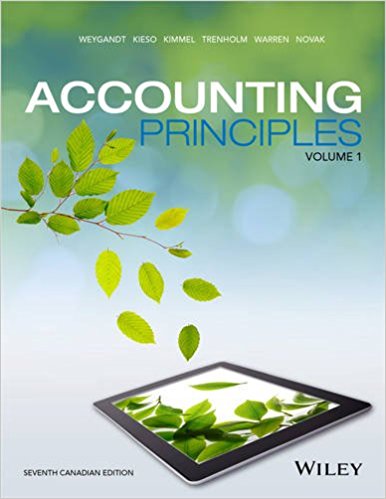Test Bank For Accounting Principles 7Th Canadian Edition Volume 1 By Jerry J. Weygandt
Digital item No Waiting Time Instant DownloadISBN-13: 978-1119310297 ISBN-10: 1119310296
In Stock
Original price was: $55.00.$22.00Current price is: $22.00.
Test Bank For Accounting Principles 7Th Canadian Edition Volume 1 By Jerry J. Weygandt
CHAPTER 2 THE RECORDING PROCESS
CHAPTER Learning OBJECTIVES
1. Describe how accounts, debits, and credits are used to record business transactions. Debit means left and credit means right. The normal balance of an asset is a debit because assets are on the left side of the accounting equation. Assets are increased by debits and decreased by credits. The normal balance of liabilities and owner’s capital is a credit because they are on the right side of the accounting equation. Liabilities and owner’s capital are increased by credits and decreased by debits. Revenues increase owner’s equity and therefore are recorded as credits because credits increase owner’s equity. Credits increase revenues and debits decrease revenues. Expenses and drawings decrease owner’s equity and therefore are recorded as debits because debits decrease owner’s equity. Expenses and drawings are increased by debits and decreased by credits.
2. State how a journal is used in the recording process and journalize transactions. The steps in the recording process are the first three steps in the accounting cycle. These steps are: (a) analyze each transaction for its effect on the accounts, (b) record the transaction in a journal, and (c) transfer the journal information to the correct accounts in the ledger.
A journal: (a) discloses the complete effect of a transaction in one place, (b) provides a chronological record of transactions, (c) helps to prevent and locate errors because the debit and credit amounts for each entry can be easily compared, and (d) explains the transaction and, if there is one, identifies the source document.
3. Explain how a ledger helps in the recording process and post transactions. The entire group of accounts maintained by a company is called the ledger. The ledger keeps in one place all the information about changes in each of the specific account balances. Posting is the procedure of transferring journal entries to the ledger accounts. After the journal entries have been posted, the ledger will show all of the increases and decreases that have been made to each account.
4. Prepare a trial balance. A trial balance is a list of the accounts in the ledger and the account balances at a specific time. Its main purpose is to prove that debits and credits are equal after posting. A trial balance uncovers certain types of errors in journalizing and posting, and is useful in preparing financial statements. Preparing a trial balance is the fourth step in the accounting cycle.
Exercises
Exercise 1
Identify each of the following accounts as an asset, liability, equity, revenue or expense.
1. L. Ralph, Capital _____________
2. Consulting Revenue _____________
3. Accounts Payable _____________
4. Office Supplies _____________
5. Prepaid Advertising _____________
6. Machinery _____________
7. Cash _____________
8. L. Ralph, Withdrawals _____________
9. Salaries Expense _____________
10. Repairs & Maintenance _____________
11. Accounts Receivable _____________
12. Unearned Revenue _____________
13. Rent Revenue _____________
Solution 1 (5 min.)
1. Equity
2. Revenue
3. Liability
4. Asset
5. Asset
6. Asset
7. Asset
8. Equity
9. Expense
10. Expense
11. Asset
12. Liability
13. Revenue
Bloomcode: Comprehension
Difficulty: Easy
Learning Objective: Describe how accounts, debits, and credits are used to record business transactions.
Section Reference: The Account
CPA: Financial Reporting
Exercise 2
For the accounts listed below, indicate if the normal balance of the account is a debit or credit.
Normal Balance
Accounts Debit or Credit
1.Repairs & Maintenance
2.Interest Receivable
3.Prepaid Insurance
4.Unearned Revenue
5.Insurance Expense
6.Fees Earned
7.Machinery
8.Notes Payable
9.Land
10.Owner Withdrawals


Reviews
There are no reviews yet.